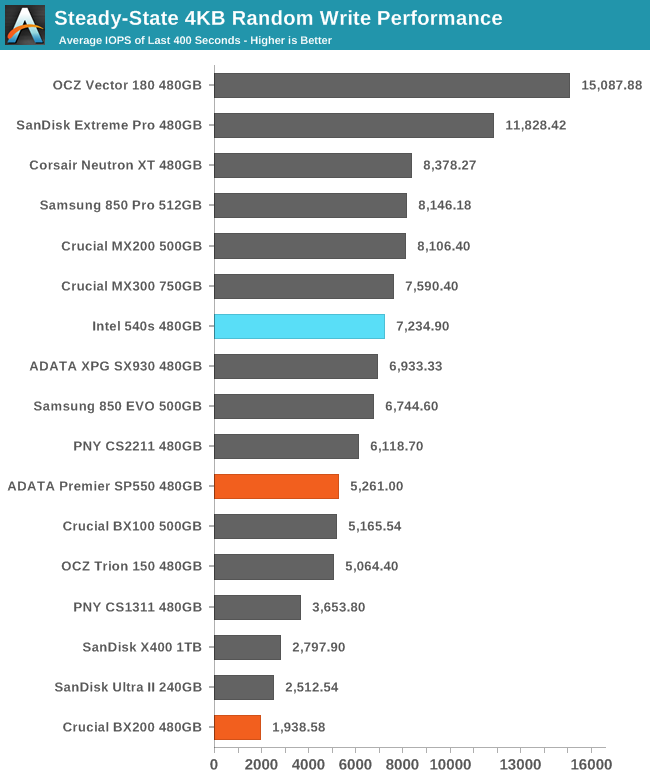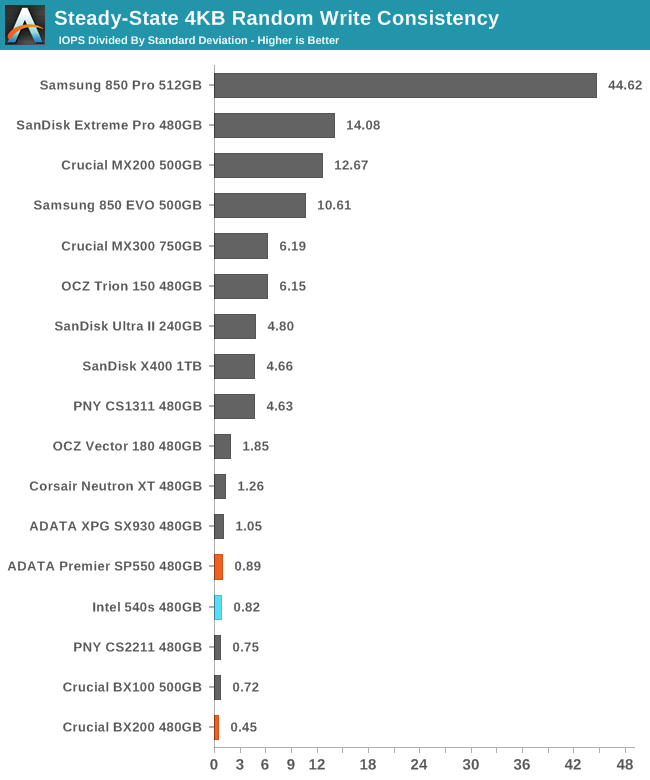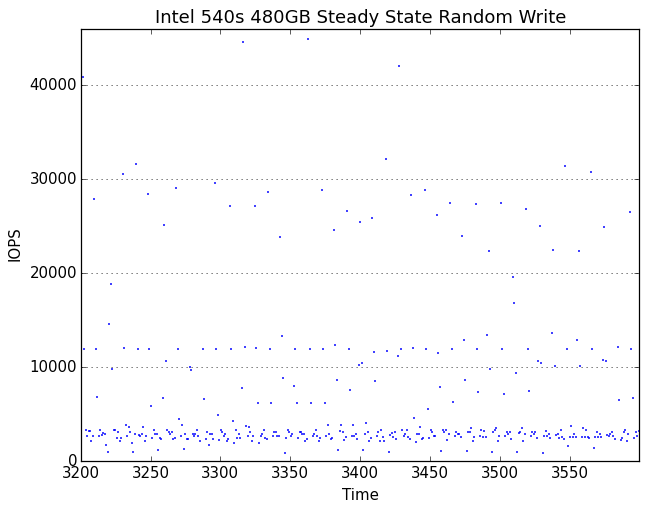The Intel SSD 540s (480GB) Review
by Billy Tallis on June 23, 2016 9:00 AM ESTPerformance Consistency
Our performance consistency test explores the extent to which a drive can reliably sustain performance during a long-duration random write test. Specifications for consumer drives typically list peak performance numbers only attainable in ideal conditions. The performance in a worst-case scenario can be drastically different as over the course of a long test drives can run out of spare area, have to start performing garbage collection, and sometimes even reach power or thermal limits.
In addition to an overall decline in performance, a long test can show patterns in how performance varies on shorter timescales. Some drives will exhibit very little variance in performance from second to second, while others will show massive drops in performance during each garbage collection cycle but otherwise maintain good performance, and others show constantly wide variance. If a drive periodically slows to hard drive levels of performance, it may feel slow to use even if its overall average performance is very high.
To maximally stress the drive's controller and force it to perform garbage collection and wear leveling, this test conducts 4kB random writes with a queue depth of 32. The drive is filled before the start of the test, and the test duration is one hour. Any spare area will be exhausted early in the test and by the end of the hour even the largest drives with the most overprovisioning will have reached a steady state. We use the last 400 seconds of the test to score the drive both on steady-state average writes per second and on its performance divided by the standard deviation.

Right from the start we see a substantial improvement of the SM2258 over SM2256, as steady-state random write speed has increased by 37%. This puts the Intel 540s well ahead of any other planar TLC drive and ahead of a few low-end MLC drives as well.

While the average random write speed has improved, the consistency is a bit worse and the Intel 540s scores in the bottom tier of drives. Phison's most recent generation of TLC drives managed to deliver very consistent steady state performance, but Silicon Motion still has a lot of room for improvement here.
 |
|||||||||
| Default | |||||||||
| 25% Over-Provisioning | |||||||||
The consistency of the 540s was clearly poor even before the transition to steady state, but during that early phase of the test it delivered twice the IOPS of the ADATA SP550.
 |
|||||||||
| Default | |||||||||
| 25% Over-Provisioning | |||||||||
Once in steady state, the 540s performance mostly stays slightly above the SP550. Both drives have frequent outliers beyond their band of usual performance, and the outliers are almost all in the direction of better performance. The Intel drive's outliers hit some much higher peaks than the ADATA SP550, suggesting that the new SM2258 controller may have significantly improved performance on bursty workloads.










77 Comments
View All Comments
cbjwthwm - Tuesday, June 28, 2016 - link
I'll pay a premium vs a generic like the SP550 because:1. Intel will undoubtedly manufacture the drive to reliable standards
2. it will be supported by a decent toolbox utility (eg: ADATA's is buggy junk)
3. Intel will rake SMI's controller firmware over the coals, like it did with Sandforce--an update has already been released since this review
4. its firmware update process will be simple & reliable
I picked up an SP550 for eval which eventually needed a firmware update. After experiencing the SP550's nasty firmware update process (a disorganized DIY mess), I now use BX200's as the cheapest drive choice simply because firmware updates are competently packaged. I've also had scenarios where fully updated OCZ Trions had terrible stuttering, and imaging to a BX200 solved the issue as well.
I see Intel's 540s as the combination of what the SMI-based TLC products like the SP550 and BX200 should be, if you combine their positive attributes (beyond price)--and for light load applications those benefits could sway me away from equivalently priced MLC-based drives with similar support issues and potential reliability compromises.
Samsung also has crappy firmware support (eg: the repeated 840 EVO performance fixes, and the 850 series update bricking issues which were pulled) so I rarely ever use them. Samsung may have an engineering lead, but they have a well established history as a consistently reckless company when it comes to support.
vladx - Tuesday, June 28, 2016 - link
Another idiot spreading FUD about Samsung. 840 EVO works great and as new after applying the fix. Stuff like the trash you posted starts stupid myths that average joes keep repeating.cbjwthwm - Wednesday, June 29, 2016 - link
Myths? There is an established track record with them, widely reported and easy to find.1. Multiple rounds of 840 EVO firmware: http://www.anandtech.com/show/9196/samsung-release...
2. 850 firmware pulled, and the ISOs were never re-released: http://www.guru3d.com/news-story/after-samsung-840...
fanofanand - Thursday, June 30, 2016 - link
The evo issue was legitimate. That said, it isn't like Intel hasn't released a few turds in their day as well. Between broken AVX and numerous other problems, Intel is not the holy grail of perfection and quality control. Samsung has at least as strong a track record for reliability with their drives as Intel, so it makes no sense to purchase this over the comparatively priced Samsung drive. You reference "premium vs generic" but line this up in the premium vs premium space and you will find this drive underperforms and is overpriced. You are either an Intel shareholder, employee, or don't use critical thinking when it comes to your beloved brand.vladx - Thursday, June 30, 2016 - link
There were issues which they fixed. I call that great support from Samsung. It's FUD to say Samsung has a bad history based on fixed issues.Prof-Q - Tuesday, August 16, 2016 - link
If Intel 540 and Adata SP550 used the same NAND, then why Intel's performance is so much better in UsersBenchmark?I was about to buy Intel but this article made me reconsider the options
SeanJ76 - Tuesday, October 4, 2016 - link
Intel will still be the king of SSD's, their top tier is no 1 in speed and reliability(Pci-e) version, their mid tier is holding their own as well, and their entry level tier, 540 series, is so damn affordable for the reliability who wouldn't buy them? I own 4 Intel 520/535 series currently, 2 of them are over 5 yrs old and they are still at 100% life span according to Intel's Toolbox. The main difference in brands is reliability, now that they're all pretty much on par with speed, you should go with the reliability winner which is none other than INTEL!